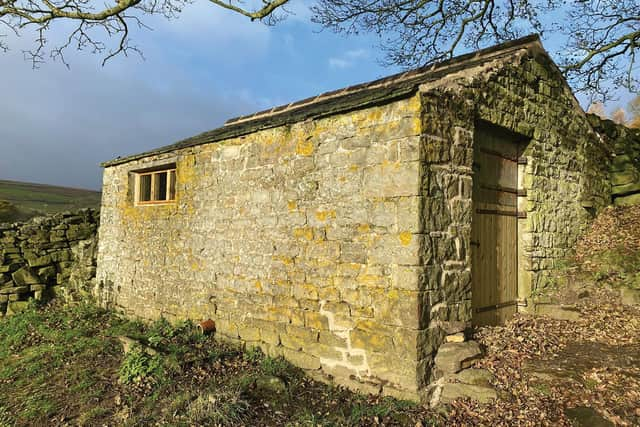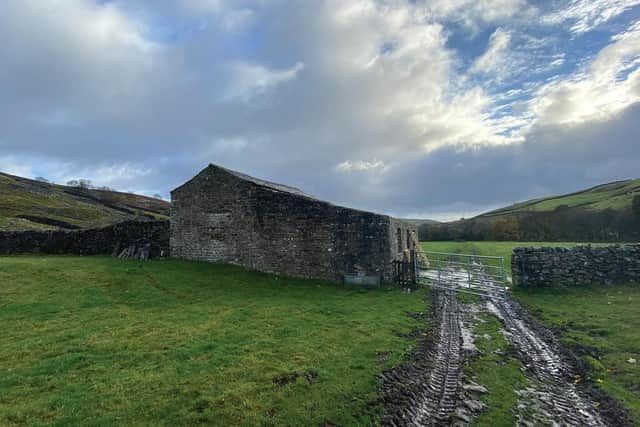All Creatures Great and Small: Two traditional Dales 'cow houses' restored thanks to donation from James Herriot creator's family
A donation from Rosie Page, Alf Wight’s daughter, has enabled Yorkshire Dales Millennium Trust, working with the Yorkshire Dales National Park Authority, to bring the two Arkengarthdale barns - or cow houses as they are traditionally called - back to their former glory.
Specialist contractors have repaired the roofs of the cow houses, located near the hamlets of Low Eskeleth and Whaw, by re-using the stone roofing flags. They also replaced defective timbers and lintels and repointed with a traditional lime mortar.
Advertisement
Hide AdAdvertisement
Hide AdAt the Whaw cow house an information panel has been installed, depicting the life of Alf Wight, better known by his pen name James Herriot. Arkengarthdale was a key location for the filming of the original BBC All Creatures TV series about his experiences of living and working as a vet in the Dales.


Rosie Page said: “Dad was brought up in Glasgow; he was a city boy, but with a deep-seated love of the great outdoors. From the moment he first saw the view of the Swale valley from Grinton Moor, he was enchanted by the Yorkshire Dales, and he had a particular affinity with the wild scenery of Swaledale and Arkengarthdale. Over the years he imbued my brother Jim and I with the same love of these remote areas.
“I feel privileged to be in a position to be able to help, in a small way, with the wonderful work which YDMT are doing to preserve the beauty and heritage of the Dales for future generations to enjoy. Donating in Dad’s memory seems absolutely right and fitting; I am certain that it is something that he would be very proud to support.”
YDMT development officer Sarah Hodgson, added: “Preserving the built and cultural heritage of this special landscape is something we have actively been involved in since 1997. In recent years, we have restored more than 10 barns and 4,050m of drystone wall, and have given grants to help local organisations protect heritage features such as water fountains and milestones across the Dales.
Advertisement
Hide AdAdvertisement
Hide Ad“We’re delighted to be able to work with the National Park Authority to preserve a feature of the Dales that Alf would have known well. It is also fitting that both barns are located in the landscape used for the filming of the original All Creatures Great and Small.


“We’re looking forward to being able to show everyone the fantastic restoration of these barns and supporting more new projects over the coming years.”
The stone-built barns of the Dales tell the story of a unique style of farming which probably started in the 17th century and continued on into living memory.
The cow houses - with their boskins, skelbuses and muck holes - preserve the old ‘Swardle’ dialect, which had its origins among the many Scandinavian farmers who settled in the northern dales from the eighth century AD.
Advertisement
Hide AdAdvertisement
Hide AdTo mark the completion of work on the two Arkengarthdale cow houses, the Building Conservation Officer at the Yorkshire Dales National Park Authority, Peter Reynolds, has written a blog post giving details of other recent barn restorations in the National Park
Yorkshire Dales National Park Authority member Derek Twine said: “YDMT are making a great contribution to the restoration of barns and we have been able to assist farmers to draw on a couple of other funding streams, too. But the overall picture is somewhat bleak. There are thousands of field barns in the National Park and many of them are in a poor state of repair. They are no longer used for their original purpose and farmers often haven’t the resources to keep them up.
“At the moment a handful of barns are being restored each year - which is great - but we really need to increase that to 70-80 a year to begin to properly conserve this special quality of the Yorkshire Dales National Park. Nowhere else in the country will you see such a unique landscape of barns and walls. Around 20 years ago the public money was there for barn restoration, but at the moment it has all but dried up, which makes us all the more grateful that YDMT are attracting charitable donations such as that received from Rosie Page.
“It’s worth saying that we’re not looking for public subsidy for every barn. Some barns are suitable for conversion to other uses. Barns close to roads have the potential to be converted to houses or alternative economic uses, although many of them are in locations that make conversion impossible without severely damaging the world-famous Dales landscape.”
Advertisement
Hide AdAdvertisement
Hide AdAn objective of the current Yorkshire Dales National Park Management Plan is to secure significant funding to repair, restore, and - where appropriate - find adaptive new uses for traditional field barns, particularly those in Swaledale, Arkengarthdale and Littondale.

